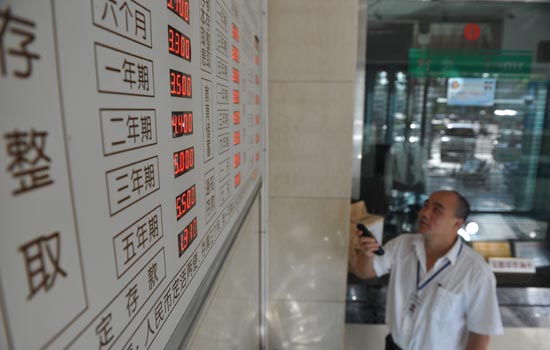Lenders 'must adapt to challenges'
By Wang Xiaotian (China Daily) Updated: 2012-06-30 09:03
|
 |
|
A bank employee adjusts interest rates displayed on an electronic board on June 8 at an Agricultural Bank of China branch in Qionghai, Hainan province. [Photo/China Daily] |
The banking industry must adapt to the challenges generated from interest rate liberalization, and keep more profits at hand to ease capital pressure caused by credit expansion, China's top banking regulator said on Friday.
Shang Fulin, chairman of the China Banking Regulatory Commission, urged banks to further improve their deposit and loan services, develop intermediary business, and expand channels to collect non-interest income.
He made the remarks while attending the Lujiazui Forum in Shanghai.
China made a breakthrough in liberalizing its interest rates this month by allowing the interest rate paid on bank deposits to exceed the benchmark rate for the first time.
On June 8, the central bank gave lenders permission to offer savers' deposit rates up to 10 percent higher than the government benchmark, while allowing them to offer discount on the key lending rate of up to 20 percent, as compared to 10 percent previously.
The move has put increasing pressure on commercial lenders, as most banks are scrambling for deposits to meet regulatory rules that require them to keep loans at a certain proportion of deposits.
"We've already seen that there are various deposit rates on the market, which is quite different from the past. Apart from major State-owned bank, most commercial lenders have priced their deposits at the highest level," said Cao Yuanzheng, chief economist at Bank of China Ltd, who added that the price difference among banks will increase in the future.
Li Daokui, a former adviser to the central bank's monetary policy committee and a professor at Tsinghua University, said he expected there will be further widening of the permitted range around the benchmark rate.
A series of new regulations due to take effect next year will add to banks' pressure to supplement capital.
The CBRC has announced tougher criteria for their capital adequacy ratio, and will publish standards for liquidity indicators very soon, a CBRC official told China Daily.
"Under the new regulatory framework, banks should raise capital through multiple channels. The CBRC and ministries are working on more channels for lenders to supplement capital, including issuing preference shares, adopting innovative capital instruments, and going to overseas markets," Shang said.
He said the new regulations to contain liquidity risks across the banking sector have been approved by the State Council and will be published at an appropriate time.
Banks are facing rising credit and liquidity risks in the financing of loans to local governments and in the real estate market, Shang wrote earlier in an essay published in Qiushi, a journal under the Communist Party of China Central Committee.
The CBRC will apply new regulatory parameters, such as the liquidity coverage ratio, which sets the standards on highly liquid assets held by banks to meet short-term obligations, and the net stable funding ratio, which measures medium- and long-term funding of banks' assets, according to Shang.
wangxiaotian@chinadaily.com.cn
- JD.com signs deal with Guizhou to develop e-commerce in rural areas
- China's reforms 'suitable' to spur economic growth: Argentine economist
- AIIB vows to engage private sector across world in Asia's infrastructure investment
- Local firm seeks foreign clients at China-ASEAN Expo
- China crucial for Chilean mining sector: Chilean minister
- Haier spearheads new model of innovation
- Leap in Chinese tourists drives record New Zealand visitor numbers
- Railway to connect China, Thailand
















